Alteration in Hydrologic Regimes and Dominant Influencing Factors in the Upper Heilong-Amur River Basin across Three Decades
Abstract
:1. Introduction
2. Materials and Methods
2.1. Study Area
2.2. Data Sources
2.3. Methods
2.3.1. Statistical Analysis Methods
- (1)
- Mann–Kendall non-parametric text
- (2)
- Cumulative anomaly method
2.3.2. IHA-RVA Method
- (1)
- Indicators of hydrological alteration
- (2)
- Degree of change in hydrological regime
- (3)
- Hydrological variation
2.3.3. Runoff Change Attribution Decomposition Method
- (1)
- Rainfall–runoff double cumulative curve
- (2)
- Quantitative estimation of runoff change
3. Results
3.1. Evolution Characteristics of the Hydrological Factors
3.1.1. Trend Analysis
3.1.2. Mutation Analysis
3.2. Hydrological Variation
3.2.1. Degree of Overall Hydrologic Change
3.2.2. Degree of Change in Hydrologic Indicators
- (1)
- As shown in Figure 8, there were decreasing trends in monthly median streamflow variability at all three hydrological stations, with those during the wet season (June–October) and dry season (November–February) significant at 28% and 26%, respectively. The monthly average decreases during the wet and dry seasons at LGH exceeded 39% and 35%, respectively. KLS showed the slightest monthly median variation at 19% and 15% in the wet and dry seasons, respectively. There were significantly decreasing trends in the monthly median water levels at all three hydrological stations at 2%, particularly during the flood water period when the water levels decreased significantly, and each water level indicator showed a medium change.
- (2)
- There were varying degrees of decrease in the extreme annual changes in streamflow (water levels) among the three hydrological stations, and that at LGH was the most obvious at 32%. However, only LGH showed a moderately decreasing trend in the baseflow index, whereas SMC and KLS showed increasing trends with low variability. The three hydrological stations showed clear decreasing trends in the median annual extreme water levels, with several indicators showing high decreases, and the decrease in the 30 d minimum streamflow of SMC reached 100%.
- (3)
- There were different advancements in the timing of annual extreme streamflow (water levels) among the other stations, with the annual minimum and maximum streamflow occurring 9 d and 3 d earlier at LGH, respectively; further, that for SMC was 14 d and 36 d, respectively, while that for KLS was 12 d and 13 d, respectively. In addition, KLS showed the most significant change in the annual extreme streamflow. The annual maximum streamflow at all three stations occurred from late June to early July, whereas the yearly minimum streamflow occurred from mid-to-late March at LGH and SMC and from early-to-mid October at KLS. The different stations showed different trends in the timing of the annual extreme water levels, with the timing of the minimum water levels delayed by 27 d at LGH, whereas the timing of the maximum water levels did not change; the timings of the minimum and maximum water levels at SMC were delayed and advanced by 6 d and 7 d, respectively and KLS was 14 d and 15 d, respectively.
- (4)
- LGH showed significant changes in streamflow pulse and duration, respectively, with a 100% change in the degree of low streamflow duration. There were also substantial increases in the duration of high streamflow at SMC and KLS, whereas they showed decreases in the frequency of high streamflow pulses. LGH and KLS showed prominent decreasing trends in the frequency of high magnitude streamflow of 100%, with moderate changes in the frequency of high water levels and duration.
- (5)
- All three stations showed decreasing trends in the streamflow rate and frequency after the mutation, and that at LGH was the highest, where the change in the degree of rising frequency index was 100%. LGH and SMC showed significant decreasing trends in streamflow reversal indices. The results showed an upward trend in the number of reversals at LGH with a low degree of change, whereas there were decreasing trends at SMC and KLS with a high degree of change.
3.3. Analysis of the Driving Factors of the Hydrologic Regime Alteration
4. Discussion
5. Conclusions
- (1)
- During the period of 1987 to 2017, the annual mean precipitation in the upper HARB was 386 mm, decreasing slightly at 0.81 mm/a. Notably, all three hydrological stations registered decreasing trends in annual mean streamflow, with the LGH station observing the most substantial decrease at 8.28 × 108 m3/a. There was also a significant decreasing trend in the annual mean water levels, with the most pronounced decline recorded at KLS station at a rate of 0.02 m/a.
- (2)
- The annual mean streamflow and water levels at LGH and SMC exhibited abrupt changes in 1998, while KLS experienced this shift in 1995. The degrees of reduction of streamflow following these changes were 58%, 42%, and 38% at LGH, SMC, and KLS, respectively, indicating moderate alterations. Correspondingly, alterations in water levels were registered at 48%, 53%, and 59%, respectively, also reflecting moderate changes.
- (3)
- Among the 32 hydrological indicators of the IHA–RVA method, there were significantly decreasing monthly trends in median streamflow and water levels, with the rate of change in the wet season (28%) slightly exceeding that in the dry season (26%). Significant decreasing trends existed in the frequencies of high and low streamflow and water levels. There were insignificant increasing trends in the high pulse duration of streamflow at SMC and KLS.
- (4)
- The contribution of precipitation in runoff variability far exceeds that of anthropogenic activities, with 62%, 84%, and 90% from precipitation and 38%, 16%, and 10% from anthropogenic activities at LGH, SMC, and KLS three hydrological stations, respectively. Precipitation is the primary factor influencing runoff in the HARB.
Author Contributions
Funding
Data Availability Statement
Conflicts of Interest
Appendix A
| IHA Parameter Group | Hydrologic Parameters | Ecosystem Influences |
|---|---|---|
| Group 1 Magnitude of monthly water conditions | Median streamflow (water level) for each hydrological month (subtotal 12 parameters) | Habitat availability for aquatic organisms. Soil moisture availability for plants. Availability of water for terrestrial animals. Availability of food/cover for fur-bearing mammals. Reliability of water supplies for terrestrial animals. Access by predators to nesting sites. Influences water temperature, oxygen levels, and photosynthesis in water column. |
| Group 2 Magnitude and duration of annual extreme water conditions | 1-day minimum 3-day minimum 7-day minimum 30-day minimum 90-day minimum 1-day minimum 3-day minimum 7-day minimum 30-day minimum 90-day minimum Zero streamflow (water level) days Base flow index (subtotal 12 parameters) | Balance of competitive, ruderal, and stress-tolerant organisms. Creation of sites for plant colonization. Structuring of aquatic ecosystems by abiotic vs. biotic factors. Structuring of river channel morphology and physical habitat conditions. Soil moisture stress in plants. Dehydration in animals. Anaerobic stress in plants. Volume of nutrient exchanges between rivers and floodplains. Duration of stressful conditions such as low oxygen and concentrated chemicals in aquatic environments. Distribution of plant communities in lakes, ponds, and floodplains. Duration of high flows for waste disposal and aeration of spawning beds in channel sediments. |
| Group 3 Timing of annual extreme water conditions | Maximum streamflow (water level) date Minimum streamflow (water level) date (subtotal 2 parameters) | Compatibility with life cycles of organisms. Predictability/voidability of stress for organisms. Access to special habitats during reproduction or to avoid predation. Spawning cues for migratory fish. Evolution of life history strategies, behavioral mechanisms. |
| Group 4 Frequency and duration of high and low pulses | Low pulse count Low pulse duration High pulse count High pulse duration (subtotal 4 parameters) | Frequency and magnitude of soil moisture stress for plants. Frequency and duration of anaerobic stress for plants. Availability of floodplain habitats for aquatic organisms. Nutrient and organic matter exchanges between river and floodplain. Soil mineral availability. Access for waterbirds to feeding, resting, and reproduction sites. Influences bedload transport, channel sediment textures, and duration of substrate disturbance (high pulses). |
| Group 5 Rate and frequency of water condition changes | Rise rates Fall rates Number of hydrologic reversals (subtotal 3 parameters) | Drought stress on plants (falling levels). Entrapment of organisms on islands and floodplains (rising levels). Desiccation stress on low-mobility stream edge (variable zone) organisms. |
References
- UNESCO. UN-Water: United Nations World Water Development Report 2020: Water and Climate Change, Paris, UNESCO. 2020. Available online: https://unhabitat.org (accessed on 1 April 2023).
- WMO. 2021 State of Climate Service (WMO-NO. 1278). 2021. Available online: https://earthobservations.org (accessed on 1 April 2023).
- IPCC. Climate Change 2021: The Physical Science Basis. In Contribution of Working Group I to the Sixth Assessment Report of the Intergovernmental Panel on Climate Change; Cambridge University Press: Cambridge, UK, 2021. [Google Scholar] [CrossRef]
- Qin, D.H.; Ding, Y.J.; Zhai, P.M.; Song, L.C.; Luo, Y.; Jiang, K.J. Evolution of Climate and Ecological Environment in China 2021; China Science Press: Beijing, China, 2020; pp. 26–27. [Google Scholar]
- Ding, Y.; Zhang, S.; Wu, J.; Zhao, Q.; Li, X.; Jia, K. Recent progress on studies on cryospheric hydrological progress changes in China. Adv. Water Sci. 2020, 31, 690–702. [Google Scholar] [CrossRef]
- Kuang, Y.; Li, H.; Xia, J.; Yang, Z.C. Impacts of climate change on transboundary water resources and adaptation management framework. Clim. Change Res. 2018, 14, 67–76. [Google Scholar] [CrossRef]
- Xia, J.; Shi, W. Perspective on water security issue of changing environment in China. Shui Li Xue Bao 2016, 47, 292–301. [Google Scholar] [CrossRef]
- He, D.M.; Liu, C.M.; Feng, Y.; Hu, J.M.; Ji, X.; Li, Y.G. Progress and perspective of international river researches in China. Acta Geogr. Sin. 2016, 27, 928–934. [Google Scholar] [CrossRef]
- Song, Y.Y.; Song, C.C. An Introduction to National Key Research and Development Project: “Research on the Response of Wetland Ecosystems in Mid-high Latitudes toon the Response of Wetland Ecosystems in Mid-high Latitudes to Climate Change Climate Change” (No. 20162016YFAYFA06023000602300). Wetl. Sci. 2016, 14, 750–754. [Google Scholar] [CrossRef]
- Chen, H. Hydrological Processes and Wetlands Distribution under Climate Change in the Amur River Basin: Impacts and Predictions. Ph.D. Thesis, Aerospace Information Research Institute, Chinese Academy of Sciences, Beijing, China, 2020. [Google Scholar] [CrossRef]
- Zhong, S.J.; Mao, X.Y.; Huang, X.J. Water resources exploitation and utilization of international rivers in China from the perspective of geo-security. World Reg. Stud. 2022, 31, 466–477. [Google Scholar] [CrossRef]
- Chen, J.W. Cooperation and prospective on transboundary rivers between China and its neighboring countries. J. Bound. Ocean Stud. 2019, 4, 60–70. [Google Scholar]
- Guo, L.D.; Jing, P.R.; Zhang, Y.K. Visualization analysis on the research hotspots and frontiers of China’s international rivers. World Reg. Stud. 2022, 31, 490–502. [Google Scholar] [CrossRef]
- Bao, Z.X.; Zhang, J.Y.; Wang, G.Q.; Chen, Q.W.; Guan, T.S.; Yan, X.L.; Liu, C.S.; Liu, J.; Wang, J. The impact of climate variability and land use/cover change on the water balance in the Middle Yellow River Basin, China. J. Hydrol. 2019, 577, 123942. [Google Scholar] [CrossRef]
- Wang, H.X.; Ma, Y.C.; Hong, F.T.; Yang, H.; Huang, L.T.; Jiao, X.Y.; Guo, W.X. Evolution of Water–Sediment Situation and Attribution Analysis in the Upper Yangtze River, China. Water 2023, 15, 574. [Google Scholar] [CrossRef]
- Wang, S.P.; McVicar, T.R.; Zhang, Z.Q.; Brunner, T.; Strauss, P. Globally partitioning the simultaneous impacts of climate-induced and human-induced changes on catchment streamflow: A review and meta-analysis. J. Hydrol. 2020, 590, 125387. [Google Scholar] [CrossRef]
- Su, L.; Miao, C.Y.; Kong, D.X.; Duan, Q.Y.; Lei, X.H.; Hou, Q.Q.; Li, H. Long-term trends in global river flow and the causal relationships between river flow and ocean signals. J. Hydrol. 2018, 563, 818–833. [Google Scholar] [CrossRef]
- Zhang, Y.Q.; Zheng, H.X.; Zhang, X.Z.; Leung, L.R.; Liu, C.M.; Zheng, C.M.; Guo, Y.H.; Francis, H.S.; David, P.; Kong, D.D.; et al. Future global streamflow declines are probably more severe than previously estimated. Nat. Water 2023, 1, 261–271. [Google Scholar] [CrossRef]
- Yang, L.; Zhao, G.J.; Tian, P.; Mu, X.M.; Tian, X.J.; Feng, J.H.; Bai, Y.P. Runoff changes in the major river basins of China and their responses to potential driving forces. J. Hydrol. 2022, 607, 127536. [Google Scholar] [CrossRef]
- Li, F.P.; Zhang, G.X.; Xu, J.Y. Spatiotemporal variability of climate and streamflow in the Songhua River Basin, northeast China. J. Hydrol. 2014, 514, 53–64. [Google Scholar] [CrossRef]
- Yan, B.; Xia, Z.Q.; Zhou, Y.X.; Wang, J.C.; Chen, Q.C. Variation of runoff at Khabarovsk Station on Heilongjiang River. Water Resour. Prot. 2013, 29, 29–33. [Google Scholar] [CrossRef]
- Richter, B.D.; Baumgartner, J.V.; Powell, J.; Braun, D.P. A method for assessing hydrologic alteration within ecosystems. Conserv. Biol. 1996, 10, 1163–1174. [Google Scholar] [CrossRef] [Green Version]
- Richter, B.D.; Baumgartner, J.V.; Braun, D.P.; Powell, J. A spatial assessment of hydrologic alteration within a river network. Regul. Rivers-Res. Manag. 1998, 14, 329–340. [Google Scholar] [CrossRef]
- Richter, B.D.; Baumgartner, J.V.; Wigington, R.; Braun, D. How much water does a river need? Freshw. Biology 1997, 37, 231–249. [Google Scholar] [CrossRef] [Green Version]
- Tian, X.J.; Zhao, G.J.; Mu, X.M.; Zhang, P.F.; Tian, P.; Gao, P.; Sun, W.Y. Hydrologic alteration and possible underlying causes in the Wuding River, China. Sci. Total Environ. 2019, 693, 133556. [Google Scholar] [CrossRef]
- Xu, M.Z.; Wang, G.H.; Wang, Z.J.; Hu, H.C.; Kumar Singh, D.; Tian, S.M. Temporal and spatial hydrological variations of the yellow river in the past 60 years. J. Hydrol. 2022, 609, 127750. [Google Scholar] [CrossRef]
- Li, H.W.; Zhao, G.J.; Mu, X.M.; Tian, P.; Zhang, S.S. Alteration of Hydrological Regime and Analysis on Its Diving Factors of the Weihe River Basin. Reach. Soil Water Conserv. 2022, 30, 1–7. [Google Scholar] [CrossRef]
- Liu, Z.R.; Zhou, H.W.; Hu, X.Q. Multi-period and multi-layer cooperation mechanism of cross-border flood prevention in Heilongjiang Basin. China Popul. Resour. Environ. 2015, 25, 163–168. [Google Scholar] [CrossRef]
- Wang, R.; Yin, Z.J.; Zhu, C.Z. Analysis of Rainstorms and Floods Occurred in Heilongjiang and Songhuajiang River Basins in 2013. J. China Hydrol. 2014, 36, 67–71+76. [Google Scholar]
- Huang, Y.F.; Li, T.J.; Lv, E.Z.; Li, J.Y.; Bai, R.; Liu, C.; Shi, R.X. Boundary Data of the Amur River Basin. J. Glob. Change Data Discov. 2017, 1, 114. [Google Scholar] [CrossRef]
- Dai, C.L.; Wang, S.C.; Li, Z.J.; Gao, Y.; Li, C. Review on hydrological geography in Heilongjiang River Basin. Acta Geogr. Sin. 2015, 70, 1823–1834. [Google Scholar] [CrossRef]
- Guo, J. Hydrography of the Heilongjiang River Basin; New Knowledge Press: Shanghai, China, 1958; pp. 45–53. [Google Scholar]
- Luo, F. Introduction to the Hydrology of the Heilongjiang River Basin; Academy Press: Beijing, China, 1996; pp. 45–53. [Google Scholar]
- Dai, C.L.; Yu, C.G.; Lin, L.; Xiao, D.F.; Li, H.Y. Analysis of Characteristics of Hydrology and Water Resources of the Heilong (Amur) River Basin. Adv. Mater. Res. 2012, 550–553, 2525–2532. [Google Scholar] [CrossRef]
- Menne, M.J.; Williams, C.N.; Gleason, B.E.; Rennie, J.J.; Lawrimore, J.H. The global historical climatology network monthly temperature dataset, version 4. J. Clim. 2018, 31, 9835–9854. [Google Scholar] [CrossRef]
- Mann, H.B. Nonparametric tests against trend. Econometrica 1945, 13, 245–259. [Google Scholar] [CrossRef]
- Kendall, M.G. Rank Correlation Methods; Charles, Griffin: New York, NY, USA, 1975. [Google Scholar]
- Lv, X.Z.; Zuo, Z.G.; Ni, Y.X.; Sun, J.; Wang, H.N. The effects of climate and catchment characteristic change on streamflow in a typical tributary of the yellow river. Sci. Rep. 2019, 9, 14535. [Google Scholar] [CrossRef] [Green Version]
- Serrano, A.; Mateos, V.L.; Garcia, J.A. Trend analysis of monthly precipitation over the iberian peninsula for the period 1921–1995. Phys. Chem. Earth 1999, 24, 85–90. [Google Scholar] [CrossRef]
- Yue, S.; Pilon, P.; Phinney, B.; Cavadias, G. The influence of autocorrelation on the ability to detect trend in hydrological series. Hydrol. Process 2002, 16, 1807–1829. [Google Scholar] [CrossRef]
- Hamed, K.H.; Rao, A.R. A modified Mann-Kendall trend test for autocorrelated data. J. Hydrol. 1998, 204, 182–196. [Google Scholar] [CrossRef]
- Hamed, K.H. Trend detection in hydrologic data: The Mann-Kendall trend test under the scaling hypothesis. J. Hydrol. 2008, 349, 350–363. [Google Scholar] [CrossRef]
- Kumar, S.; Merwade, V.; Kam, J.; Thurner, K. Streamflow trends in Indiana: Effects of long term persistence, precipitation and subsurface drains. J. Hydrol. 2009, 374, 171–183. [Google Scholar] [CrossRef]
- Berger, W.H.; Labeyrie, L.D. Abrupt Climatic Change: Evidence and Implications; Springer Science & Business Media: Berlin/Heidelberg, Germany, 1987. [Google Scholar]
- Shah, S.A.; Jehanzaib, M.; Lee, J.H.; Kim, T.W. Exploring the factors affecting streamflow conditions in the Han River basin from a regional perspective. Water Resour. Hydrol. Eng. 2021, 25, 4931–4941. [Google Scholar] [CrossRef]
- Wen, X.; Liu, Z.H.; Lei, X.H.; Lin, R.J.; Fang, G.H.; Tan, Q.F.; Wang, C.; Tian, Y.; Quan, J. Future changes in Yuan River ecohydrology: Individual and cumulative impacts of climates change and cascade hydropower development on runoff and aquatic habitat quality. Sci. Total Environ. 2018, 633, 1403–1417. [Google Scholar] [CrossRef]
- Allan, J.D.; Castillo, M.M. Stream 3cology: Structure and Function of Running Waters, 2nd ed.; Springer: Dordrecht, The Netherlands, 2007; pp. 40–43. [Google Scholar]
- Zuo, D.P.; Xu, Z.X.; Wu, W.; Zhao, J.; Zhao, F.F. Identification of streamflow response to climate change and human activities in the Wei River Basin, China. Water Resour. Manag. 2014, 28, 833–851. [Google Scholar] [CrossRef]
- Jehanzaib, M.; Shah, S.A.; Kwon, H.H.; Kim, T.W. Investigating the influence of natural events and anthropogenic activities on hydrological drought in South Korea. Terr. Atmos. Ocean. Sci. 2020, 31, 85–96. [Google Scholar] [CrossRef] [Green Version]
- Jehanzaib, M.; Shah, S.A.; Yoo, J.Y.; Kim, T.W. Investigating the impacts of climate change and human activities on hydrological drought using non-stationary approaches. J. Hydrol. 2020, 588, 125–152. [Google Scholar] [CrossRef]
- Wei, X.; Wang, N.; Zhou, M.T.; Guo, Y.C. Combined Impact of Climate Change and Human Activities on Runoff in the Kriya River. J. Irrig. Drain. 2022, 41, 80–86. [Google Scholar] [CrossRef]
- Zhang, S.L.; Wang, Y.H.; Yu, P.T.; Zhang, H.J.; Tu, X.W. Impact of human activities on the spatial and temporal variation of runoff of Jinghe Basin, Northwest China. J. Arid Land Resour. Environ. 2011, 25, 66–72. [Google Scholar] [CrossRef]
- Ma, K.; Huang, X.R.; Liang, C.; Zhao, H.B.; Zhou, X.Y.; Wei, X.Y. Effect of land use/cove changes on runoff in the Min River watershed. River Res. Appl. 2020, 36, 749–759. [Google Scholar] [CrossRef]
- Bellevenkiel, E.; Zuo, Z.A.; Zhao, Q.Y. The role of Russian two hydropower stations in the flood of 2013. Express Water Resour. Hydropower Inf. 2014, 35, 23–27. [Google Scholar] [CrossRef]
- Song, C.S.; Zhu, X.Y.; Han, H.W.; Lin, L.B.; Yao, Z. The influence of riverway characteristics on the generation and dissipation of ice dam in the upper reaches of Heilongjiang River. Shui Li Xue Bao 2020, 51, 1256–1266. [Google Scholar] [CrossRef]
- Simonov, E.A.; Dahmer, T.D. Amur-Heilong River Basin Reader; Ecosystems Ltd.: Hong Kong, China, 2008; pp. 150–175. [Google Scholar]
- Zhang, Y.Q.; Li, C.C. The research progress on the influence of vegetation changes on regional hydrological processes in Northern China. J. Northwest Univ. 2020, 50, 420–426. [Google Scholar] [CrossRef]
- Zhang, J.Z.; Song, L.R. Research on water resources development and water allocation measures in the Hailar River Basin. Water Resour. Hydropower 2010, 28, 34–35. [Google Scholar] [CrossRef]
- Guo, H.D. Study on the Sustainable Use of Water Resources in the Hailar River Basin. Inn. Mong. Water Resour. 2008, 115, 71–73. [Google Scholar]
- Makhinov, A.; Kim, V. Effect of climate changes on the hydrological regime of the Amur river. Pac. Geogr. 2020, 1, 30–39. [Google Scholar] [CrossRef]
- Novorotskii, P. Climate changes in the amur river basin in the last 115 years. Russ. Meteorol. Hydrol. 2007, 2, 102–109. [Google Scholar] [CrossRef]
- Tishchenko, V.A.; Khan, V.M.; Kruglova, E.N.; Kulikova, I.A. Monthly and Seasonal Prediction of Precipitation and Air Temperature in the Amur River Basin. Russ. Meteorol. Hydrol. 2019, 44, 169–179. [Google Scholar] [CrossRef]
- Yu, L.L.; Xia, Z.Q.; Li, S.; Li, J.K.; Cai, T. Climate change characteristics of Amur River. Water Sci. Eng. 2013, 6, 131–144. [Google Scholar] [CrossRef]

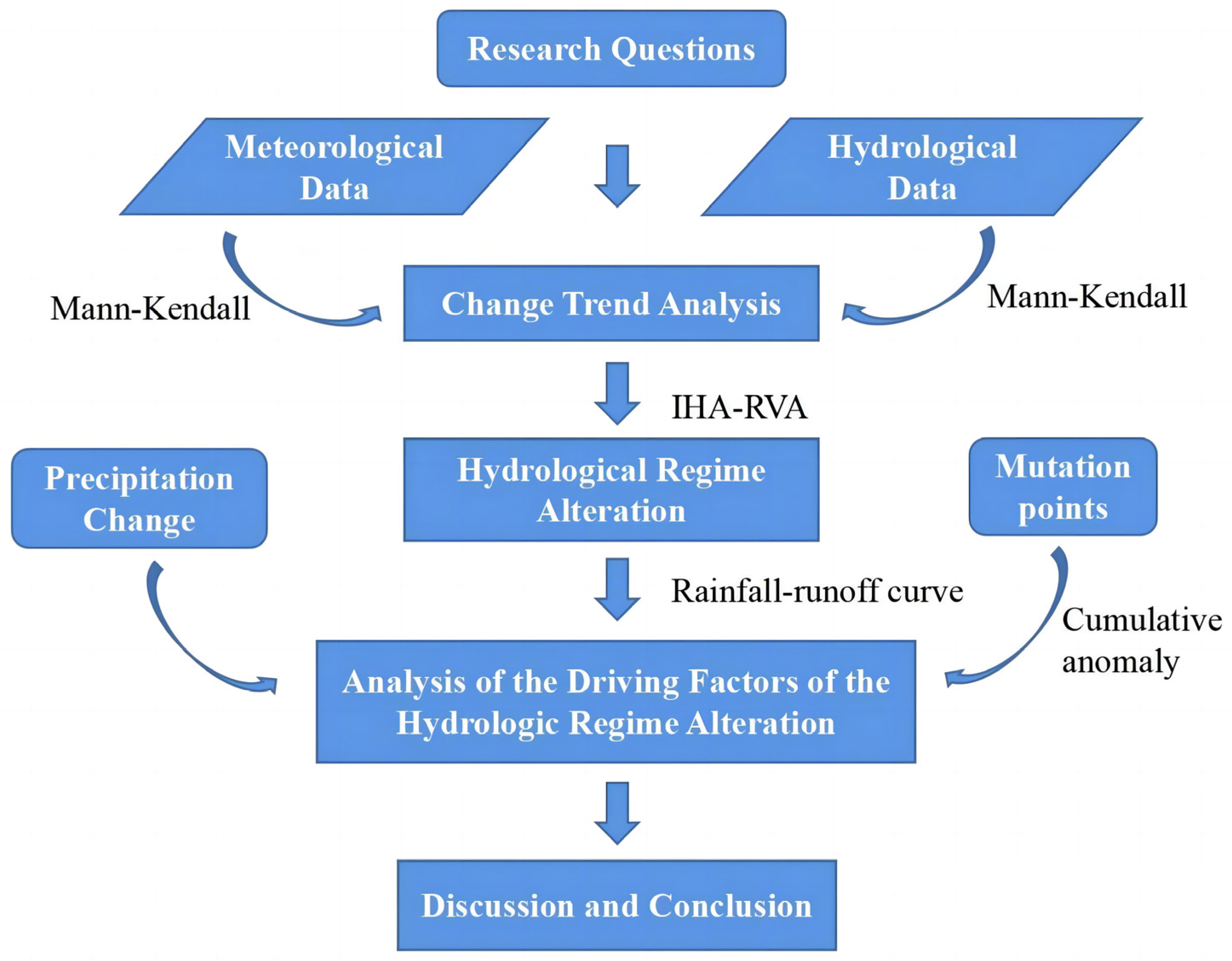
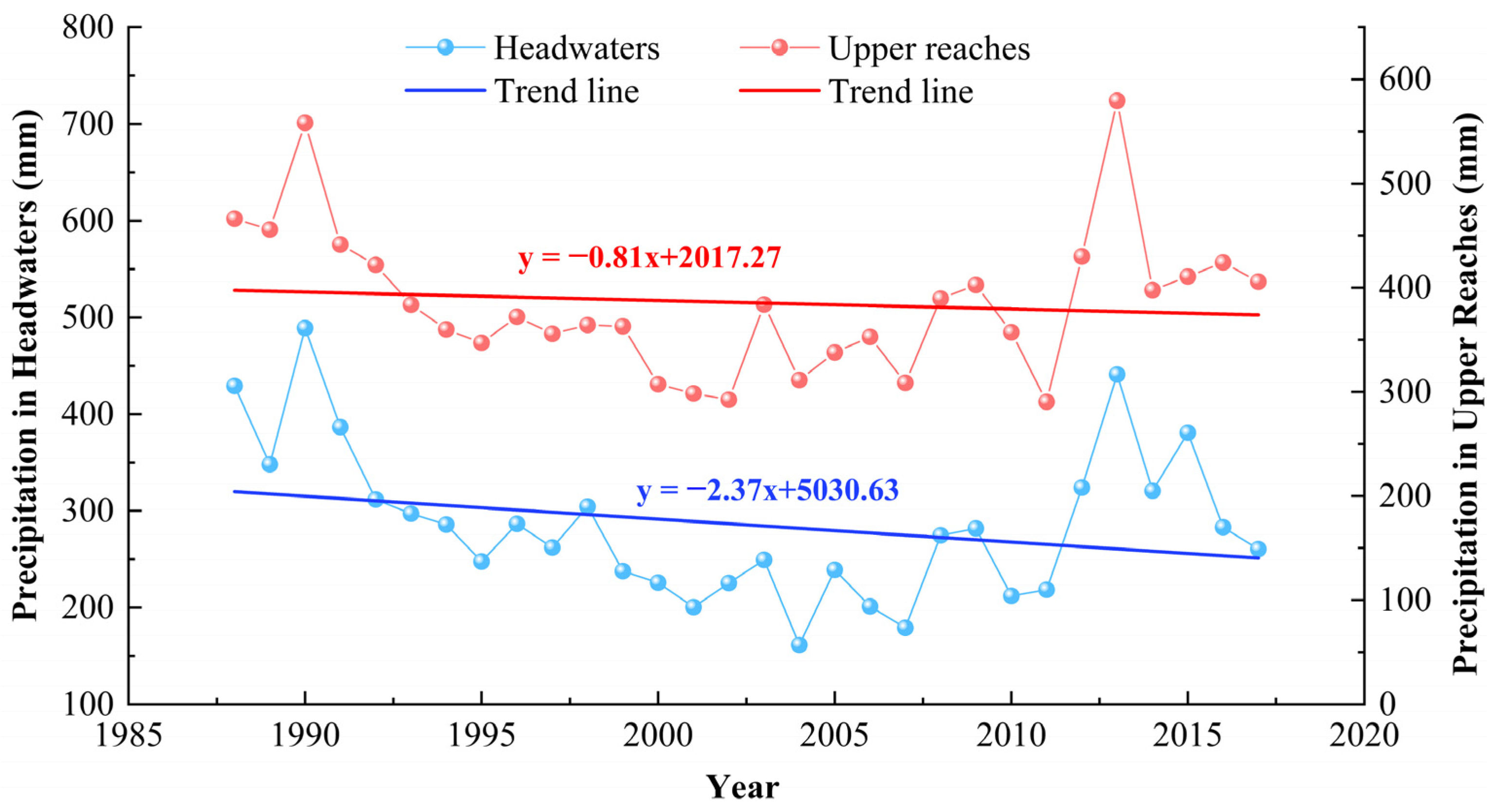
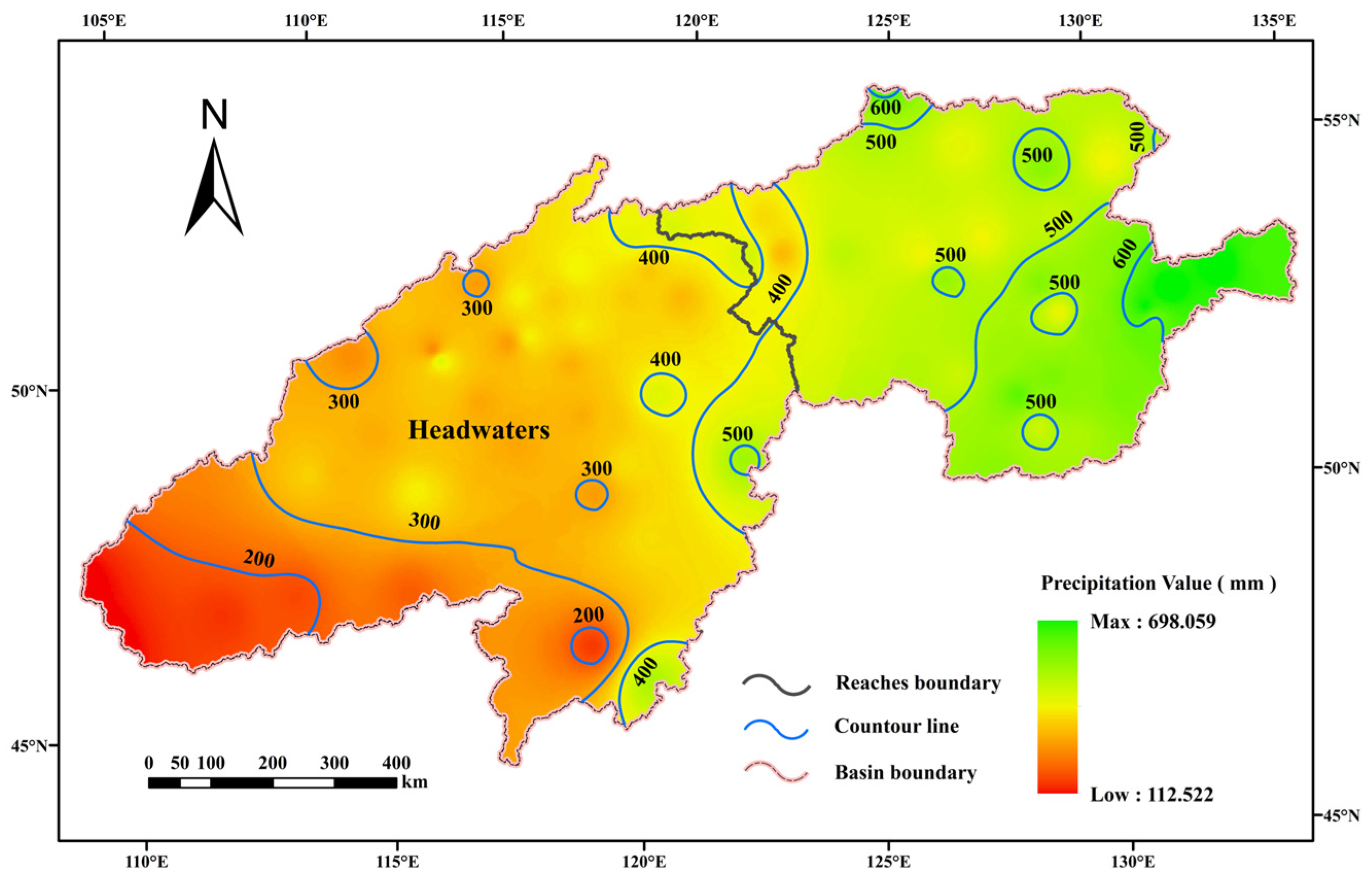


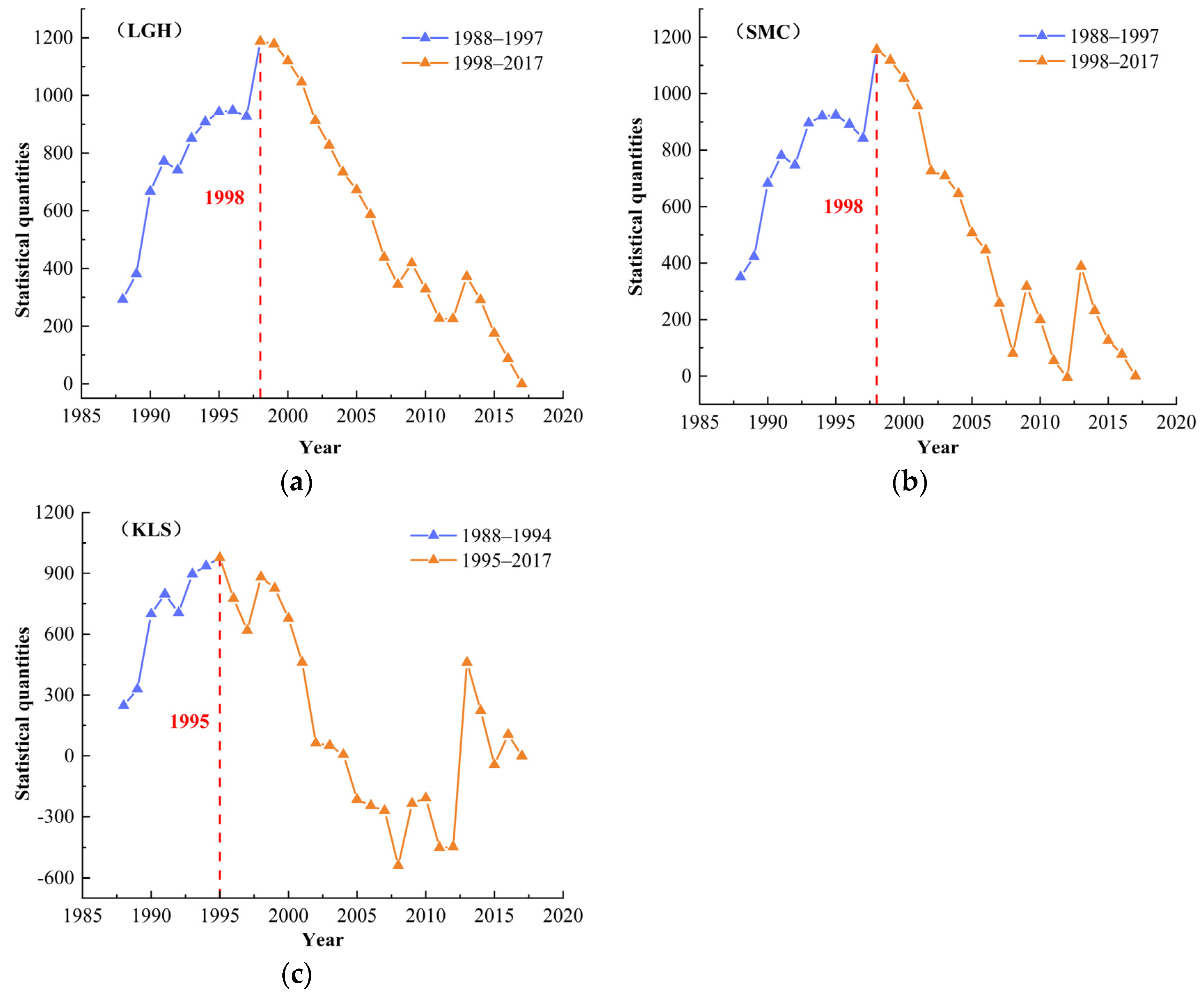

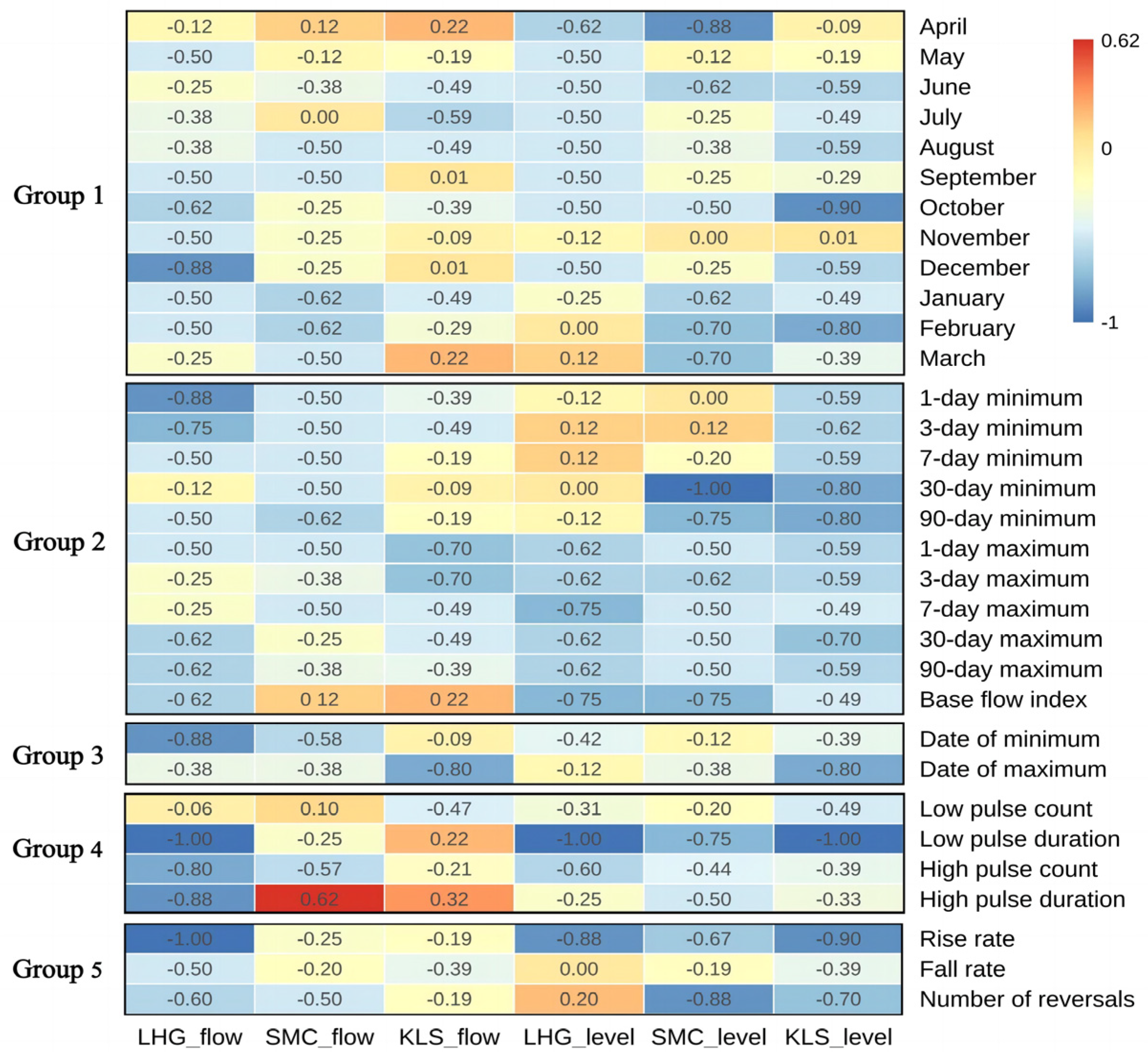
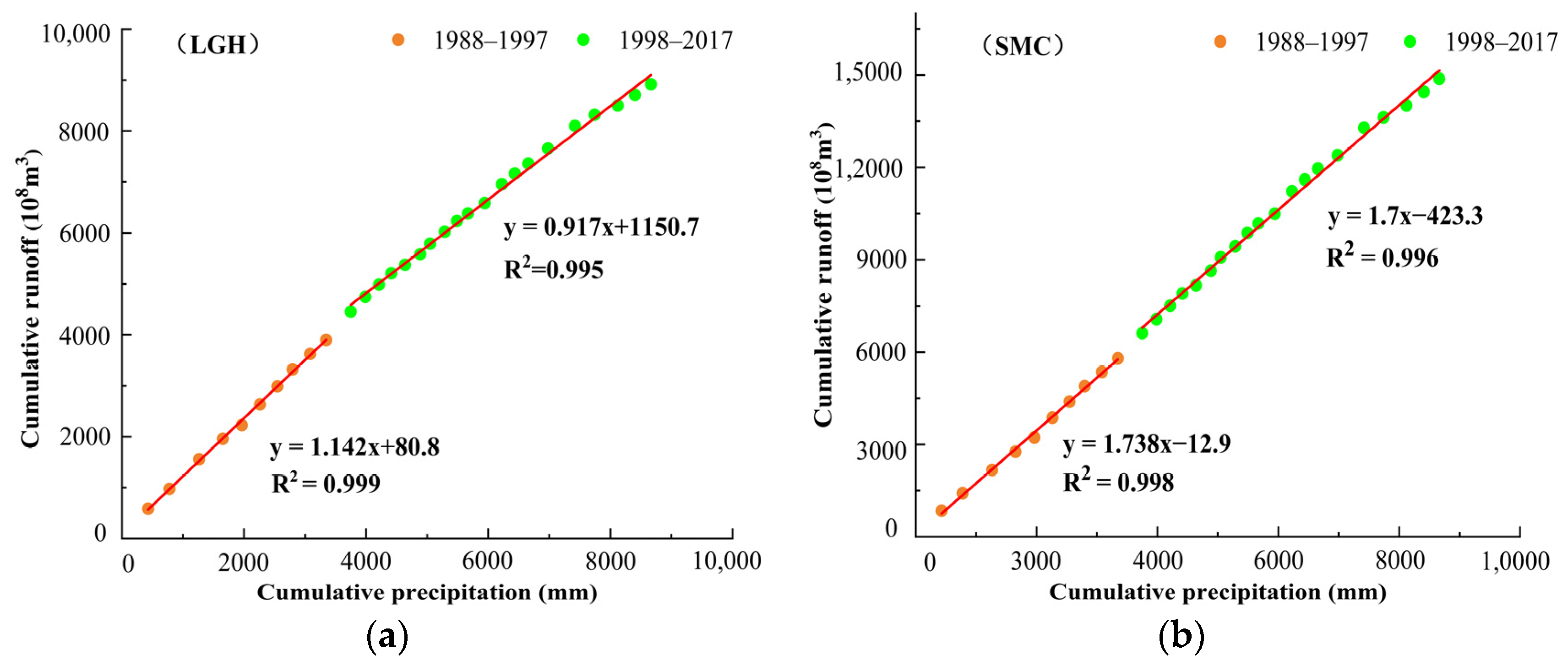
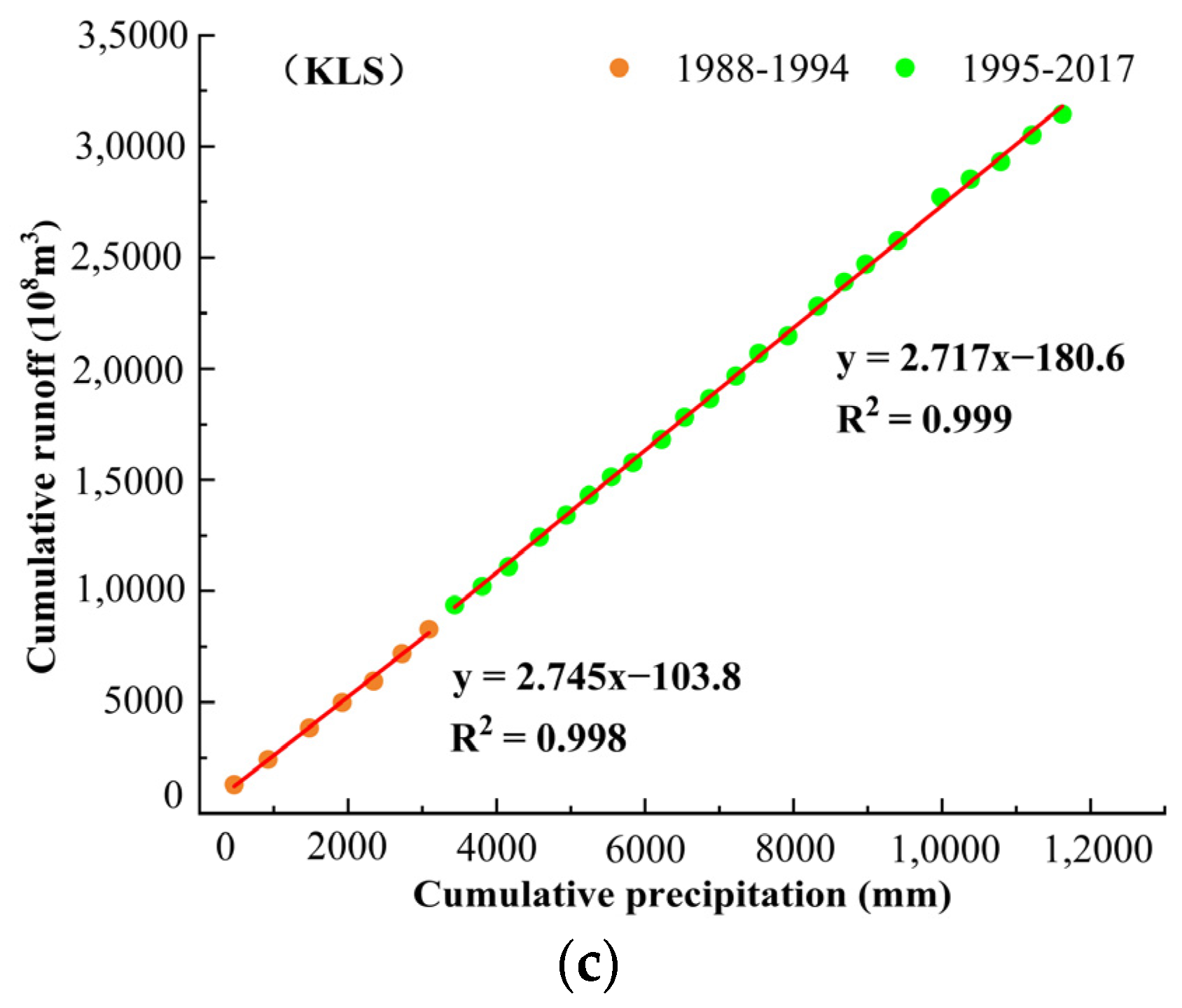
| Data Format | Contents | Data Scale | Source |
|---|---|---|---|
| Hydrological data | The streamflow and water level at Luoguhe, Shangmachang, and Kalunshan hydrological stations. | Daily monitored data for the period 1988–2017. | The Hydrological Report of Heilongjiang River Basin, China. |
| Meteorological data | Precipitation data from 75 meteorological stations in the study area. | Daily monitored data for the period 1988–2017. | The United States Global Historical Climatology Network. |
| Digital elevation model | The digital elevation model data in the study area. | 90 m spatial resolution. | The United States National Aeronautics and Space Administration. |
| Geographic data | The State Borders | The ESRI Shapefile. | The Resource and Environmental Science Data Center at the Chinese Academy of Science. |
| IHA Parameter Group | Content | Hydrologic Parameters |
|---|---|---|
| Group 1 | Magnitude of monthly water conditions (subtotal 12 parameters) | Median streamflow (water levels) for each hydrological month |
| Group 2 | Magnitude and duration of annual extreme water conditions (subtotal 12 parameters) | Annual maximum (minimum) 1, 3, 7, 30, 90 d streamflow (water levels) Zero streamflow (water levels) days Base flow index |
| Group 3 | Time of annual extreme water conditions (subtotal 2 parameters) | Maximum streamflow (water levels) date Minimum streamflow (water levels) date |
| Group 4 | Frequency and duration of high and low pulses (subtotal 4 parameters) | High (low) pulse count High (low) pulse duration |
| Group 5 | Rate and frequency of water condition changes (subtotal 3 parameters) | Rise rates Fall rates Number of hydrologic reversals |
| Hydrology Index | Stations | Hydrological Change Degree of Five Groups (%) | |||||
|---|---|---|---|---|---|---|---|
| Group 1 | Group 2 | Group 3 | Group 4 | Group 5 | |||
| Stream Flow /(m3/s) | LGH | 45 (M) | 51 (M) | 63(M) | 68 (H) | 70 (H) | 58 (M) |
| SMC | 33 (M) | 41 (M) | 48 (M) | 2 (L) | 32(L) | 42 (M) | |
| KLS | 21 (L) | 35 (M) | 44 (M) | 4 (L) | 26(L) | 38 (M) | |
| Level /(m) | LGH | 36 (M) | 36 (M) | 27 (L) | 54 (M) | 23 (L) | 48 (M) |
| SMC | 44 (M) | 47 (M) | 25 (L) | 47 (M) | 58 (M) | 53 (M) | |
| KLS | 45 (M) | 64 (M) | 44 (M) | 67 (H) | 54 (M) | 59 (M) | |
| Group | Serial Number | IHA Indicators | Change Rate of Streamflow (%) | Change Rate of Water Levels (%) | ||||
|---|---|---|---|---|---|---|---|---|
| LGH | SMC | KLS | LGH | SMC | KLS | |||
| Group 1 | 1 | Median in April | 52 | 41 | 23 | 6 | 1 | 1 |
| 2 | Median in May | 11 | −2 | −7 | 5 | 0 | 0 | |
| 3 | Median in June | 32 | 25 | 17 | 6 | 1 | 1 | |
| 4 | Median in July | 51 | 36 | 29 | 7 | 1 | 1 | |
| 5 | Median in August | 36 | 19 | 11 | 7 | 1 | 1 | |
| 6 | Median in September | 40 | 26 | 18 | 6 | 1 | 1 | |
| 7 | Median in October | 38 | 27 | 22 | 6 | 1 | 1 | |
| 8 | Median in November | 36 | 13 | 5 | 6 | 1 | 1 | |
| 9 | Median in December | 47 | 31 | 17 | 6 | 1 | 1 | |
| 10 | Median in January | 33 | 35 | 20 | 6 | 0 | 1 | |
| 11 | Median in February | 24 | 28 | 17 | 5 | 0 | 1 | |
| 12 | Median in March | 13 | 20 | 4 | 5 | 0 | 1 | |
| Group 2 | 13 | 1-day minimum | 44 | 27 | 16 | 5 | 0 | 1 |
| 14 | 3-day minimum | 44 | 28 | 13 | 5 | 0 | 1 | |
| 15 | 7-day minimum | 45 | 29 | 7 | 5 | 0 | 1 | |
| 16 | 30-day minimum | 18 | 23 | 10 | 5 | 0 | 1 | |
| 17 | 90-day minimum | 28 | 24 | 15 | 5 | 0 | 1 | |
| 18 | 1-day maximum | 27 | 9 | 13 | 7 | 1 | 1 | |
| 19 | 3-day maximum | 28 | 10 | 13 | 8 | 1 | 1 | |
| 20 | 7-day maximum | 29 | 9 | 12 | 7 | 1 | 1 | |
| 21 | 30-day maximum | 30 | 11 | 9 | 7 | 1 | 1 | |
| 22 | 90-day maximum | 34 | 17 | 14 | 67 | 1 | 1 | |
| 23 | Base index | 10 | 5 | −7 | −6 | −1 | −1 | |
| Group 3 | 24 | Date of minimum | 12 | 13 | 12 | −34 | −2 | −5 |
| 25 | Date of maximum | 2 | 6 | 7 | 0 | 1 | 7 | |
| Group 4 | 26 | Low pulse count | −4 | −29 | 23 | −102 | −13 | 20 |
| 27 | Low pulse duration | −16 | 12 | −63 | 23 | 2 | −133 | |
| 28 | High pulse count | 44 | 30 | 22 | 53 | 9 | 26 | |
| 29 | High pulse duration | −54 | 19 | −24 | −5 | 14 | 30 | |
| Group 5 | 30 | Rise rate | 46 | 36 | 28 | 1 | 10 | 17 |
| 31 | Fall rate | 47 | 22 | 23 | 783 | 3 | 18 | |
| 32 | Number of reversals | −24 | −11 | 3 | 7 | −4 | 5 | |
| Stations | Period | Measured Values /(108 m3) | Calculated Values/(108 m3) | Measured Runoff Variation | Precipitation Impact | Anthropogenic Activities Impact | |||
|---|---|---|---|---|---|---|---|---|---|
| Change Amount/(108 m3) | Percent | Change Amount/(108 m3) | Percent | Change Amount/(108 m3) | Percent | ||||
| LGH | 1988–1997 | 390.02 | - | - | - | - | - | - | - |
| 1998–2017 | 250.94 | 303.81 | 139.08 | 35.66% | 86.21 | 61.99% | 52.87 | 38.01% | |
| SMC | 1988–1997 | 601.11 | - | - | - | - | - | - | - |
| 1998–2017 | 435.15 | 462.48 | 165.95 | 27.61% | 138.63 | 83.53% | 27.33 | 16.47% | |
| KLS | 1988–1994 | 1170.59 | - | - | - | - | - | - | - |
| 1995–2017 | 1004.11 | 1021.12 | 166.48 | 14.22% | 149.47 | 89.78% | 17.01 | 10.22% | |
Disclaimer/Publisher’s Note: The statements, opinions and data contained in all publications are solely those of the individual author(s) and contributor(s) and not of MDPI and/or the editor(s). MDPI and/or the editor(s) disclaim responsibility for any injury to people or property resulting from any ideas, methods, instructions or products referred to in the content. |
© 2023 by the authors. Licensee MDPI, Basel, Switzerland. This article is an open access article distributed under the terms and conditions of the Creative Commons Attribution (CC BY) license (https://creativecommons.org/licenses/by/4.0/).
Share and Cite
Zhang, K.; Ma, K.; Leng, J.; He, D. Alteration in Hydrologic Regimes and Dominant Influencing Factors in the Upper Heilong-Amur River Basin across Three Decades. Sustainability 2023, 15, 10391. https://doi.org/10.3390/su151310391
Zhang K, Ma K, Leng J, He D. Alteration in Hydrologic Regimes and Dominant Influencing Factors in the Upper Heilong-Amur River Basin across Three Decades. Sustainability. 2023; 15(13):10391. https://doi.org/10.3390/su151310391
Chicago/Turabian StyleZhang, Kaiwen, Kai Ma, Jiwei Leng, and Daming He. 2023. "Alteration in Hydrologic Regimes and Dominant Influencing Factors in the Upper Heilong-Amur River Basin across Three Decades" Sustainability 15, no. 13: 10391. https://doi.org/10.3390/su151310391




